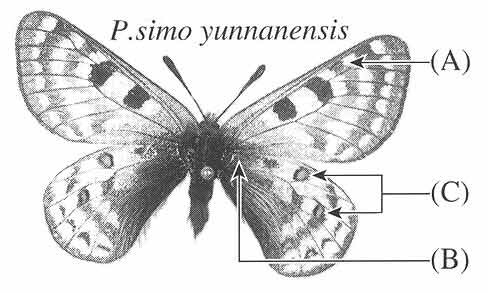
in coll.Kawasaki(Oita,JAPAN).
Paratype(including Allotype):8 males, 5 females Mt.Baima Xueshan, alt.4300m- 5000m, 28" 19' N/97" 58' E, 8- 14 Jun.1989:
12 males, 7 females Same data as holotype:14 males, 9 females Mt.Baima Xueshan, 28" 21' N/99" 03' E, 30 May-3 Jun.1992
6 males, 6 females S. of Deqen, Baima Pass alt.4600m, 26 Jun.1998 Leg A. Gorodinski.
Paratype(including Allotype):8 males, 5 females Mt.Baima Xueshan, alt.4300m- 5000m, 28" 19' N/97" 58' E, 8- 14 Jun.1989:
12 males, 7 females Same data as holotype:14 males, 9 females Mt.Baima Xueshan, 28" 21' N/99" 03' E, 30 May-3 Jun.1992
6 males, 6 females S. of Deqen, Baima Pass alt.4600m, 26 Jun.1998 Leg A. Gorodinski.

-Summary- Very interesting population of Parnassius simo had been obtained from Mt.Baima Xueshan, Northern Yunnan CHINA on 1989 - 1997. This population has particular peculiarities and distinguishable from neighbouring subspecies described from Eastern TIBET and Western Sichuan, by the following cha- racteristics. So I describe this population as a new subspecies in this paper. This subspecific name is derived from Yunnan CHINA. |
 |
- Fore wing length, 19mm ~~ 24mm, smaller than ssp.lenzeni and ssp.fickleri.
- Ground colour is yellowish cream.
- Red ocellus in cell 8 of fore wing is absent in almost speciments, while in ssp.fickleri it is well developed.
- Marginal black band and submarginal black spots series of hind wing are well developed.
- Basal black scales of hind wing are very well developed.
- Red ocelli in cells 5 and 7 of hind wing are smaller than those of neighbouring subspecies.
- Basal red ocellus on underside of hind wing is absent in almost speciments, on the other hand, in ssp.fickleri it is usually well developed.

- Acknowledgements-
I would like to express special thanks to following persons for their kindness and support.
Dr.Klaus Rose, Mr.Willi Fickler, Mr.Robert Westphal, Dr.J.C.Weiss Late, Mr. Wako Kitawaki, Mr.Andre Gorodinski, Dr.Kyoichiro
Ueda, Dr.Keiichi Omoto, Mr.Seiji Sakai, Mr.Shiro Sugisawa, Mr.Akio Shinkai, Mr.Hidehiko Mikami, Mr.Shigeru Inaoka, Mr.Bin
Koiwaya, Mr.Yasuyuki Watanabe, Mr.Keishi Nishida, Mr.Alois Helia, Mr.Evgeniy Tarasov, Mr.Yasushi Sorimachi, Dr. Ammosov
Oleg, Dr. Zdenek Mracek. -References-
Geith,K.,1995. Bericht uber die Parnassiidae-Ausbeute einer Ost-Tibet-Expedition:facetta Separatum Nr.12
Koiwaya,S.,1995. Re-assortment of Parnassius simo and Parnassius andreji,-On the discovery of sympatric habitat of P.simo and
P.andreji, with the description of new ssp.of andreji:Gekkan-Mushi No.297,8 ~ 13.
Weiss,J.C.,1991. The Parnassiinae of the World PartI, 11 - 18.
Brk,F.,1935. Das Tierreich Parnassiinae pars 11, 654 ~- 673.
Kawasaki,Y.& Helia,A.,1996. Description of three new subspecies of the Genus Pamassius Latreille from TIBET expedition on
1995:WALLACE Vol.2,17 - 22.
Omoto,K.& Kawasaki,Y,. 1998. Some new parnassiinae butterflies from Nepal in the Haruta-collection: Trans, lepid.
Soc. Japan 49(3), 147 ~ 155.
I would like to express special thanks to following persons for their kindness and support.
Dr.Klaus Rose, Mr.Willi Fickler, Mr.Robert Westphal, Dr.J.C.Weiss Late, Mr. Wako Kitawaki, Mr.Andre Gorodinski, Dr.Kyoichiro
Ueda, Dr.Keiichi Omoto, Mr.Seiji Sakai, Mr.Shiro Sugisawa, Mr.Akio Shinkai, Mr.Hidehiko Mikami, Mr.Shigeru Inaoka, Mr.Bin
Koiwaya, Mr.Yasuyuki Watanabe, Mr.Keishi Nishida, Mr.Alois Helia, Mr.Evgeniy Tarasov, Mr.Yasushi Sorimachi, Dr. Ammosov
Oleg, Dr. Zdenek Mracek. -References-
Geith,K.,1995. Bericht uber die Parnassiidae-Ausbeute einer Ost-Tibet-Expedition:facetta Separatum Nr.12
Koiwaya,S.,1995. Re-assortment of Parnassius simo and Parnassius andreji,-On the discovery of sympatric habitat of P.simo and
P.andreji, with the description of new ssp.of andreji:Gekkan-Mushi No.297,8 ~ 13.
Weiss,J.C.,1991. The Parnassiinae of the World PartI, 11 - 18.
Brk,F.,1935. Das Tierreich Parnassiinae pars 11, 654 ~- 673.
Kawasaki,Y.& Helia,A.,1996. Description of three new subspecies of the Genus Pamassius Latreille from TIBET expedition on
1995:WALLACE Vol.2,17 - 22.
Omoto,K.& Kawasaki,Y,. 1998. Some new parnassiinae butterflies from Nepal in the Haruta-collection: Trans, lepid.
Soc. Japan 49(3), 147 ~ 155.
